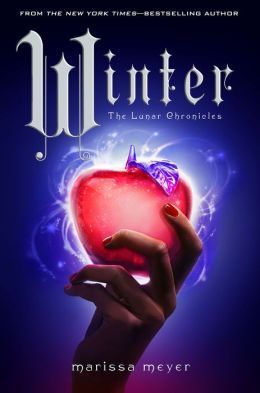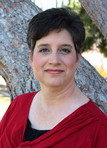Laurisa White Reyes's Blog, page 98
May 20, 2015
DEFINING "NEW ADULT"

Have you heard of "New Adult" books? It's a still relatively new label for books aimed at 17-25 year-olds who are bridging from books like Twilight, Hunger Games and Harry Potter into more adult titles, but the emphasis seems to be sex. Yup. There are quite a few raised eyebrows about it. I think it might be a good thing and here's why.
I've had conversations with many parents of adolescent readers and there is a common misconception that Young Adult books have sex in them. Now, it is true that many YA books do have some sex and/or deal with issues relating to sexuality, but not all YA books do. In fact, from what I've read, a large portion of YA books are "clean." But those books that aren't have given the YA category a bad rap.
 Unlike music, TV and movies (which have ratings) you don't know what's in a book until you read it. This is problematic for many parents. I have on occasion read a book only to be "surprised" half way through. Personally I don't like those kind of surprises. While I am not advocating a rating system for books, maybe creating this "New Adult" category might help siphon off some of the more sexier YA books, making it easier for readers and parents of teen readers to distinguish books with more "adult" content.
Unlike music, TV and movies (which have ratings) you don't know what's in a book until you read it. This is problematic for many parents. I have on occasion read a book only to be "surprised" half way through. Personally I don't like those kind of surprises. While I am not advocating a rating system for books, maybe creating this "New Adult" category might help siphon off some of the more sexier YA books, making it easier for readers and parents of teen readers to distinguish books with more "adult" content.Leslie Kaufman at New York Times wrote an awesome article about it. Take a look and tell me what you think. Is New Adult just a way for publishers and authors to sell more books, or is it a way for them to innocuously rate books with adult content?
"Vampire and wizard fans are apparently ready for characters who shed their robes and show a little more skin.
Publishers and authors say they are seeing a spurt in sales of books that fit into the young-adult genre in their length and emotional intensity, but feature slightly older characters and significantly more sex, explicitly detailed
They’ve labeled this category “new adult” — which some winkingly describe as Harry Potter meets “50 Shades of Grey” — and say it is aimed at 18-to-25-year-olds, the age group right above young adult..." Read entire article HERE.
 http://mycrazzycorner.blogspot.com/
http://mycrazzycorner.blogspot.com/
Published on May 20, 2015 09:00
May 17, 2015
MIDDLE SHELF MAGAZINE: COOL READS FOR COOL KIDS
Got kids?
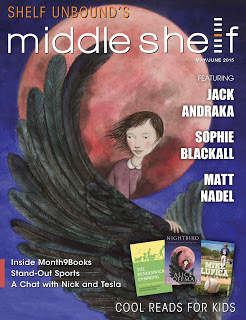
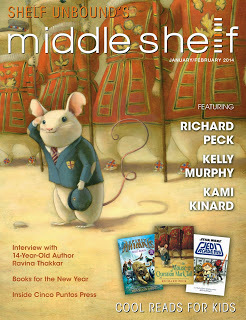
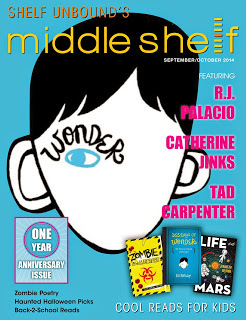
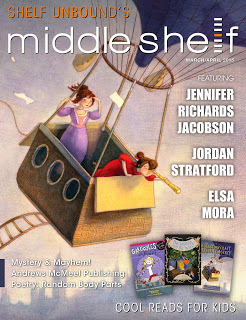
Check out the May/June issue of MIDDLE SHELF MAGAZINE: COOL READS FOR COOL KIDS:
http://issuu.com/middleshelf/docs/middle_shelf_may-june_2015
Middle Shelf hit the digital newstands in October 2013 and has boasted interviews with some of today's best-selling & award-winning authors, including Margaret Petersen Haddix, Richard Peck, R.J. Palacio, Catherine Jinks, Chris Grabenstein, Neal Shusterman, Kirby Larson, Katherine Applegate, Cornelia Funke, and more!
Each full-color interactive issue also contains book reviews by kids for kids, excerpts from every genre, spotlighted titles on specific themes, interviews with characters from popular series, and features on the publishers that produce your kids favorite books.
Not only is every issue packed with plenty of fiction titles, but we also introduce kids to the best picks in poetry, graphic novels, non-fiction, and novelty books. We also seek out young authors who break the mold and prove you don't have to be old to live your dreams. Our aim is to help kids ages 8 - 14 find their next favorite book, over and over again.
Middle Shelf Magazine is the perfect Language Arts resource for classrooms, libraries, and homes. The best part is that online subscriptions are FREE! Subscribe today: http://www.shelfmediagroup.com/pages/subscribe-middle-shelf.html
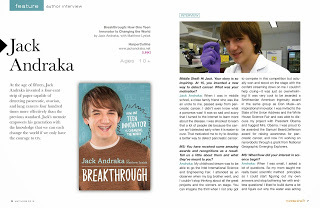
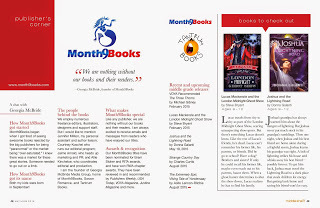




Check out the May/June issue of MIDDLE SHELF MAGAZINE: COOL READS FOR COOL KIDS:
http://issuu.com/middleshelf/docs/middle_shelf_may-june_2015
Middle Shelf hit the digital newstands in October 2013 and has boasted interviews with some of today's best-selling & award-winning authors, including Margaret Petersen Haddix, Richard Peck, R.J. Palacio, Catherine Jinks, Chris Grabenstein, Neal Shusterman, Kirby Larson, Katherine Applegate, Cornelia Funke, and more!
Each full-color interactive issue also contains book reviews by kids for kids, excerpts from every genre, spotlighted titles on specific themes, interviews with characters from popular series, and features on the publishers that produce your kids favorite books.
Not only is every issue packed with plenty of fiction titles, but we also introduce kids to the best picks in poetry, graphic novels, non-fiction, and novelty books. We also seek out young authors who break the mold and prove you don't have to be old to live your dreams. Our aim is to help kids ages 8 - 14 find their next favorite book, over and over again.
Middle Shelf Magazine is the perfect Language Arts resource for classrooms, libraries, and homes. The best part is that online subscriptions are FREE! Subscribe today: http://www.shelfmediagroup.com/pages/subscribe-middle-shelf.html


Published on May 17, 2015 17:00
May 16, 2015
ROMANCE BLOG FEST
 http://mycrazzycorner.blogspot.com/
http://mycrazzycorner.blogspot.com/ CONTACTLaurisa White ReyesHallowed Ink Press www.laurisawhitereyes.com
CONTACTLaurisa White ReyesHallowed Ink Press www.laurisawhitereyes.comIt takes only half a second..
...Like those commercials where a crash test dummy rockets forward at high speed and slams into a wall.
...In that instant, every thought in Emma Lynn Walsh's head collides with mine-every thought, memory, hope, disappointment and dream.
...I open my eyes to see Dr. Walsh peering at me, a puzzled expression on her face."Let-go-of-me," I order through clenched teeth.
Mira wants to die. She's attempted suicide twice already, and failed. Every time she comes in contact with another person, skin to skin, that person's psyche uploads into hers. While her psychologist considers this a gift, for Mira, it's a curse from which she cannot escape.
To make matters worse, Mira's father is being investigated in the deaths of several volunteer test subjects of a miracle drug. Shortly after Mira's mother starts asking questions, she ends up in a coma. Although her father claims it was an accident, thanks to her "condition" Mira knows the truth...but proving it just might get her killed!
"CONTACT is a page turner that will keep you guessing... And it will make you reconsider the next time you wish you knew someone else’s secrets!" - Margaret Peterson Haddix, author of the Missing and The Shadow Children series
AMAZON * BARNES & NOBLE * BOOK DEPOSITORY
Website: www.laurisawhitereyes.com
Blog: laurisareyes.blogspot.com
EXCERPT:
By now David has reached the slide. I push off, and my body careens around the curves and comes to a gentle rest at the bottom where he’s waiting for me. I stand up in front of him, peering into his chocolate brown eyes.
“You are different, Mira Ortiz,” he says. “You’re different in all the right ways.”“I’m a freak.”
“Not a freak. No, you’re—you’re amazing.”
For some reason what he says sets me off. “Stop trying to make me feel better, okay? I don’t want to feel better. I don’t want to feel anything ever again! I should be dead, not her!”
“Don’t say that.”
Tears threaten to start up again. I swipe at my eyes, trying to hold them at bay. “Sorry.” I try to smile. “You’re right. I’m good. It’s all good.”
“No it’s not, Mira.” David steps closer. “You’re not goodright now. You’re hurting, but I’m here. Okay? You’re not alone in this.”
“Yes I am!”
The earlier rainstorm has cooled the air. A little breeze carries the scent of damp grass and pine trees through the night.
“Don’t you get it?” I continue. “God spared me and took my mother instead.”
“What are you talking about, Mira?”
“It was too much. It was all too much, so I tried—” My voice catches in my throat, but I force the words out, “I tried to kill myself.”
The expression on David’s face is one of disbelief, shock. I grab the hem of my hoodie with both hands and jerk it up over my head. I throw it to the sand and thrust out my arm. The wound is healed now, but the deep red scar is still fresh and ugly.
“I was supposed to die! Not her!”
I don’t know what I expect from David. Revulsion? Pity? But I see nothing like that in his eyes.
He lets go of one of his crutches, still holding it beneath his arm, and reaches for me. But then he stops—hesitating. He won’t touch me. But I want him to. When he reaches out again I remain purposely still. The tiny hairs on my arm tingle as his fingers trace the air just above my scar. My skin aches for his touch.
It’s too much—this ever present barrier between us—the barricade I’ve erected between me and everyone else. I’m tired of the isolation. I want—need to feel again—to know in some way that someone understands me, cares about me.
Slowly I raise my arms and slide my hands over David’s shoulders. Lacing my fingers across the back of his shirt collar, I pull him toward me. He resists at first, a questioning look in his eyes. So I step closer, erasing the gap between us. Fighting my instinctive urge to turn and run, to protect myself from the pain and chaos, I press my body against his. I can feel his heart steadily beating in his chest, his lungs expanding and retracting with every breath. I close my eyes and lean into him.
The moment our lips connect my mind ignites with electric bursts. The burning is so intense I nearly pull away, but instead I kiss him harder. I see everything he is, everything he’s experienced and felt and learned in a lifetime. A little boy running barefoot down a cobbled street in a small Guatemalan town; savoring the sweet tastes of mango and coconut; standing in the warm torrential rains, arms outstretched, head tipped back, mouth wide open.
But there are bad memories, too, ones he’s buried deep. A father struggling to make ends meet, taking out his frustrations on his boy: a calloused hand, a leather belt, a wooden dowel, whatever was convenient and within reach. I feel the fear, the betrayal—too painful even for me. I move through them quickly only to discover an even darker void—the trauma of leaving his home and family behind, of entering a new country, a new world, and trying to find his place in it.
His more recent memories slip around each other like ice cubes melting on fevered skin. I see him at school watching someone from a distance, a girl—me. He liked me then? The realization startles me. And I see Craig, my boyfriend, and David’s intense loathing of him. Then there are his memories of seeing me at Dr. Walsh’s office, the fundraiser, everything over the past few days. I feel the depth of compassion he felt watching me fall apart tonight, wanting so much to comfort me, knowing he couldn’t.
And the longing—his agonizing longing—for me.
Our kiss ends, and I look up at him. I want to ask him, is this for real? But I know it is. I know everything about him. I know that his every thought is for me, that he wants so desperately for me to understand how he feels, but that he would never compromise my trust in him. Never.
I kiss David again, and this time he kisses me back—hard and passionate. My fingers brush up the back of his neck into his hair. I’m so consumed with him I don’t even feel the pain anymore. His lips skim along my chin and throat, the tops of my shoulders. His hands caress my back—delicate, like a whisper. He smells so good—vanilla and spice. I breathe deeply, letting him fill my senses.
I hear the crutches hit the sand as David’s arms slip around my body, holding me even closer. But I want more. Feeling a desperate hunger for contact, I grasp the hem of David’s shirt and lift it, dragging it up his arms until it comes free. Warmth radiates from his russet skin, smooth and curved over joints and muscles. Wearing just my thin cotton tank top, I feel horribly exposed. Fighting the impulse to wrap my arms defensively around myself, I wrap my arms around David instead.
Touching him again, all I see is him. His passion envelopes me completely, like the shield of warm night air that surrounds us. My hands sweep over the contours of his shoulder blades and spine down to the small of his back. Gliding up again along his sides, my fingers graze a patch of raised, irregular skin—a scar.
At that moment something inside of David shifts—a change so subtle I might not have noticed if I weren’t so connected to him. He stiffens ever so slightly in my arms, and a thought—no, not even that—an impressionleaches from his psyche into mine:
Regret.
Published on May 16, 2015 17:00
May 15, 2015
BOOK REVIEW: THE REAL WIZARD OF OZ by Rebecca Loncraine
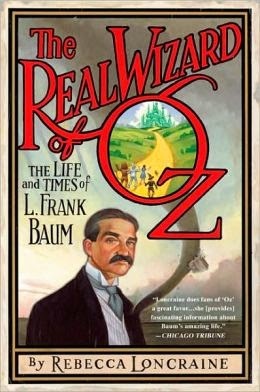 THE REAL WIZARD OF OZ: THE LIFE AND TIMES OF L. FRANK BAUM
THE REAL WIZARD OF OZ: THE LIFE AND TIMES OF L. FRANK BAUMRebecca Loncraine
Penguin Publishing Group/Oasis Audio
In the first major literary biography of L. Frank Baum, Rebecca Loncraine tells the story of Oz as you've never heard it, with a look behind the curtain at the vivid life and eccentric imagination of its creator
L. Frank Baum wrote The Wonderful Wizard of Oz in 1899 and it was first published in 1900. A runaway hit, it was soon recognized as America's first modern fairy tale. Baum's life story, like the fictional world he created, is uniquely American, rooted in the transforming historical changes of his times. Baum was a complex and eccentric man who could never stay put for long; his restless creative spirit and voracious appetite for new projects led him across the U.S. during his lifetime, and he drew energy and inspiration from each new dramatic landscape he encountered,. Born in 1856, Baum spent his youth in the Finger Lakes region of New York as amputee soldiers returned from the Civil War; childhood mortality was also commonplace, blurring the lines between the living and the dead, and making room in Baum's young imagination for vividly real ghosts. When Baum was growing up, P. T. Barnum ruled the minds of small towns and his traveling circus was the most famous act around. Baum married a headstrong young woman named Maud Gage and they ventured out west to Dakota Territory, where they faced violent tornadoes, Ghost Dancing tribes and desperate droughts, before trading the hardships on the Great Plains for the excitement of Chicago and the fantastical White City of the World's Fair.
Baum's writing tapped into an inner world that blurred his own sense of reality and fantasy. The Land of Oz, which Baum believed he had "discovered" rather than invented, grew into something far bigger and more popular than he'd ever imagined. After the roaring success of The Wonderful Wizard of Oz in 1900, he became a kind of slave to his creation, trapped inside Oz as his army of demanding child fans kept sending him back there to create new adventures for Dorothy, Toto and the humbug wizard. He went on to write thirteen sequels to his first Oz book. He also wrote the first Broadway adaptations of his Oz tales, and turned his Oz books into some of the first motion pictures in a small and undiscovered rural settlement called "Hollywood". Baum co-founded the Oz Film Manufacturing Company, even as critics warned that no one would pay to see a children's story. And they were right- his early ventures were box office flops and the world was not ready for Oz on screen until 1939, when MGM released "The Wizard of Oz" in brilliant Technicolor. Baum was not around to see it-he'd died in bed in 1919 just weeks after completing his final Oz book. But the book and film alike have become classics, just as well-loved today as they were when they first appeared.
The Real Wizard of Oz is an imaginatively written work that stretches the genre of biography and enriches our understanding of modern fairytales. L. Frank Baum, author of The Wonderful Wizard of Oz and its thirteen sequels, lived during eventful times in American history— from 1856 to 1919— that influenced nearly every aspect of his writing, from the Civil War to Hollywood, which was emerging as a modern Emerald City full of broken dreams and humbug wizards, to the gulf between America's prairie heartland, with its wild tornadoes, and its cities teeming with "Tin Man" factory workers. This is a colorful portrait of one man's vivid and eccentric imagination and the world that shaped it. Baum's famous fairytale is filled with the pain of the economic uncertainties of the Gilded Age and with a yearning for real change, ideas which many contemporary Americans will recognize. The Wizard of Oz continues to fascinate and influence us because it explores universal themes of longing for a better world, homesickness and finding inner strength amid the storms.
MY REVIEW:
I listened to this book on audio CD and was very impressed by both the narrative and narration. Covering Baum's entire life, from birth to death, Loncraine provides vivid details of every aspect of Baum's life as well as the culture and historical events which played backdrop to his life. While the author does sometimes take detours through seemingly disconnected bits of history, she does a nice job of eventually tying everything together. The result is a magical look deep inside the author's heart and soul.
I particularly appreciated the author taking the time to summarize each of the many Oz books. I had no idea there were so many in the series. Being only acquainted with the first book and the 1939 film, these insights into the other Baum creations opened new worlds for me and left me wanting to read them all.
By the time I had finished listening to the entire book, I had a new appreciation for the creative mind, and for Baum in particular. The land of Oz and all its magnificent characters are truly America's first and foremost fairytale. This biography is well worth the read.
* The CDs were provided free of charge from Oasis Audio in exchange for an honest review.




Published on May 15, 2015 00:00
May 13, 2015
THE SHAPE OF A STORY

As many of you know, I'm mid-way through grad school. One class I'm taking this semester is Advanced Narrative Writing in which we are reading and examining a wide selection of contemporary short stories by Amy Bender, Joe Hill, George Saunders, Neil Gaiman, Ben Loory and a few others.
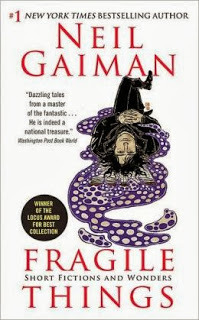 We are not reading them just for the sake of entertainment, though the stories are definitely entertaining, but we are discussing the various techniques these authors employ in crafting these stories.
We are not reading them just for the sake of entertainment, though the stories are definitely entertaining, but we are discussing the various techniques these authors employ in crafting these stories.One of the techniques we've been talking about is the shape of a story. Traditional stories tend to follow a linear path, detailing a sequence of events leading to a climax and resolution. But many of the experimental stories we are reading don't exactly fit into this pattern. Well, at first glance they do, but on closer examination they do something radically different.
For example, in the Neil Gaiman story "Other People" (from his collection Fragile Things ) the unnamed protagonist arrives in hell and is met with a demon with scars on his back and a collection of instruments of torture at his disposal. The narrator endures thousands of years of punishment that ends and begins over and over again until finally it all stops and he becomes the demon set to torture hell's newest arrival. This story has a spiral shape to it. The story wraps around on itself many times over, and finally ends where it begins.
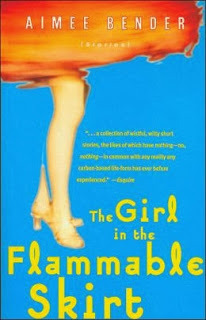 Amy Bender's story "The Rememberer" (from her collection
The Girl in the Flammable Skirt
) is even more convoluted. Beginning at the end of the story, or nearly the end, the narrator jumps back and forth in time, describing the de-evolution of her boyfriend from human to ape to finally--something microscopic and primordial. Very odd story, but an excellent example of how the shape or structure of a story can be bent and manipulated to create something extraordinary and unpredictable.
Amy Bender's story "The Rememberer" (from her collection
The Girl in the Flammable Skirt
) is even more convoluted. Beginning at the end of the story, or nearly the end, the narrator jumps back and forth in time, describing the de-evolution of her boyfriend from human to ape to finally--something microscopic and primordial. Very odd story, but an excellent example of how the shape or structure of a story can be bent and manipulated to create something extraordinary and unpredictable.And then there are stories that are indeed linear, but do not end with a predictable, "nice-little-package" resolution. Instead, the stories seem to implode or explode or just leave you going "huh?" Like George Saunders "CivilWarLand in Bad Decline" (from his collection of the same name). This is just a bizarre tale about a wimpy kind of a guy working at a run down Civil War amusement park. He sees ghosts. Gang members get shot. Weird things happen. And then he dies. Yup. It is does in fact boggle the mind. It is a linear story, but with a frayed and tangled ending.
The reason why I mention these examples is because I've been paying closer attention to the shape of the children's stories I'm reading -- and writing. I've always been interested in weaving experimental techniques into my work. I've noticed that the vast majority of books written for children and teens are linear. Simple, straight forward, one event follows another, climax, resolution. The end. And there is nothing wrong with that. But what about stories that veer from the norm? Are there any out there?
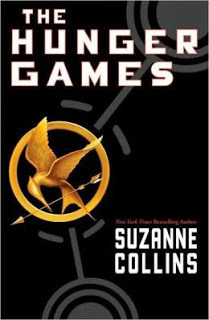 The first story (or stories) that come to mind are
The Hunger Games
books by Suzanne Collins. On the surface, these are linear stories. Right? Well, yes--but where does the story begin? With the protagonist anticipating the games in her home in District 12. Where does the series end? At the close of
Mockingjay
, Katniss is back in District 12. While the plot is linear, the overall story Arc is circular.
The first story (or stories) that come to mind are
The Hunger Games
books by Suzanne Collins. On the surface, these are linear stories. Right? Well, yes--but where does the story begin? With the protagonist anticipating the games in her home in District 12. Where does the series end? At the close of
Mockingjay
, Katniss is back in District 12. While the plot is linear, the overall story Arc is circular.Another example of a circular Arc is Neil Gaiman's The Ocean at the End of the Lane . Just the opposite of The Hunger Games series, which ends where it begins, Gaiman's story begins at the end. The narrator is an adult returning to the town of his childhood, recollecting a series of bizarre incidents which bring him full circle.
What about spiral-type stories or stories that bounce around?
The best example of these kinds of shapes I can thing of is 13 Reasons Why by Jay Asher . A boy receives a collection of cassette tapes recorded by a girl who committed suicide. The story jumps back and forth between Clay's life today and Hannah's life pre-suicide. And, like Gaiman's "Other People" it ends where it begins when Clay passes the cassettes to the next person fated to listen to them.
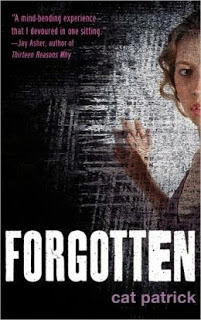 And finally one last example -
Forgotten by Cat Patrick
, a story of a girl who wakes up every day with her memory of the previous day erased. She only remembers "forward." The story is constantly skipping ahead while she tries to get through every day by piecing together the pieces of her future.
And finally one last example -
Forgotten by Cat Patrick
, a story of a girl who wakes up every day with her memory of the previous day erased. She only remembers "forward." The story is constantly skipping ahead while she tries to get through every day by piecing together the pieces of her future.All of these stories are highly experimental in form, but I'd love to see more like this. Notice, too, that they are all Young Adult books. I couldn't think of any contemporary middle grade books that tamper with story shape. (Of course there are several classical ones, such as Peter Pan and Alice and Wonderland, both circular.) Maybe this is an area that could use a little experimenting.
Can you share some other examples of children's or young adult books that play with story shape and structure?
 http://mycrazzycorner.blogspot.com/
http://mycrazzycorner.blogspot.com/
Published on May 13, 2015 09:00
May 10, 2015
MMGM: IN THE LIBRARY WITH MIDDLE SHELF
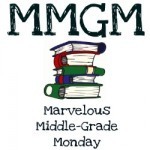 Marvelous Middle Grade Monday is sponsored by Shannon Messenger at
Ramblings of a Wannabe Scribe
. For a complete list of today's participants, visit
HERE
.
Marvelous Middle Grade Monday is sponsored by Shannon Messenger at
Ramblings of a Wannabe Scribe
. For a complete list of today's participants, visit
HERE
.In the LibrarywithMIDDLE SHELF MAGAZINE
Published on May 10, 2015 17:00
May 8, 2015
May 6, 2015
HOW DO I GET MY CHILD TO WRITE?

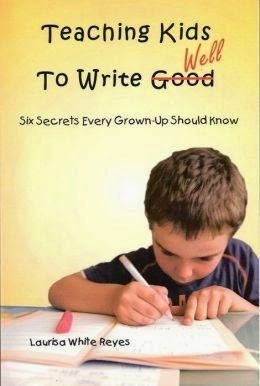
During the eight years I taught creative writing to homeschooled students, the most common question parents asked me was "How do I get my child to write?"While some children seem naturally drawn to writing, others struggle to put even a few words down on the page. Some parents describe their efforts to teach writing skills as a constant battle. Fortunately, this is one battle parents can win by following these five simple suggestions: Know Your Objective: Writing is a form of self-expression and communication. The primary goal, then, isn't to complete a particular writing assignment. Instead, it is to help your child discover the joy of writing. Utilize Technology: Some children are truly averse to the act of putting pen to paper. These kids often thrive, however, when allowed to use the computer. If they can't type, they can dictate their essay or story to you, or record it on a digital recorder.Allow Choice in Writing: The quickest way to turn children off to writing is to require them to write about something boring. Instead, encourage them to select topics that interest them.Allow Choice in Reading: Just like with writing, children need to choose books that engage their interests. Forcing a child to read a book he doesn't like will turn him off to reading, and a child who writes is a child who reads.Make Writing Fun: To help children fall in love with writing requires flexibility and creativity on your part. If your child is resistant to writing an essay, try something different, such as writing a family history, short story, comic book, or different forms of poetry.Remember, teaching your children to write does not need to be a struggle. Try these ideas at home and discover how fun writing can be.
 http://mycrazzycorner.blogspot.com/
http://mycrazzycorner.blogspot.com/
Published on May 06, 2015 09:00
May 5, 2015
SHELF UNBOUND WINS BEST DIGITAL PUBLICATION!
 On May 1st I had the honor of accepting the Maggie Award for Best Digital Publication on behalf of Margaret Brown, editor in chief and publisher of SHELF UNBOUND magazine. Shelf Unbound is the parent magazine to Middle Shelf, the children's publication of which I am editor in chief.
On May 1st I had the honor of accepting the Maggie Award for Best Digital Publication on behalf of Margaret Brown, editor in chief and publisher of SHELF UNBOUND magazine. Shelf Unbound is the parent magazine to Middle Shelf, the children's publication of which I am editor in chief.The evening was a spectacular event. My husband and I sat at a table with eight members of the Emmy Magazine staff. They went home with 5 awards!
The Maggie's are awarded by the Western Publishing Association, and I am pleased that all three of Shelf Media Groups publications -- Shelf Unbound, Middle Shelf, and Foreground -- were all finalists. But I am especially happy for Margaret, as her magazine is a wonder to behold and she has waited three years for this award.
Congratulations also to the design and editorial team, and everyone in the Shelf Media Group family. WE WON!!!

Published on May 05, 2015 09:00
May 3, 2015
COVER REVEAL: CAMP OMIGOSH by Wade Bradford
Drumroll, please! Ta da!!!!

"A wild and zany camping adventure that will leave you begging for more.”- Dorine White, author of The Awakening & Cleopatra's Legacy series
Connor's summer is off to a rough start: the camp bus almost crashes, his cabin mates don't trust him, and the girls on the other side of the camp constantly outsmart him. But when he and his friends Tasha, Parker, and Kimberly investigate the mystery surrounding the "Ghost of Dead Billy," they begin a hilarious adventure that is worlds away from your typical campfire story.
CAMP OMIGOSH is available for pre-order on Amazon, and will be released on June 25th.
Purchase for your Kindle HERE

"A wild and zany camping adventure that will leave you begging for more.”- Dorine White, author of The Awakening & Cleopatra's Legacy series
Connor's summer is off to a rough start: the camp bus almost crashes, his cabin mates don't trust him, and the girls on the other side of the camp constantly outsmart him. But when he and his friends Tasha, Parker, and Kimberly investigate the mystery surrounding the "Ghost of Dead Billy," they begin a hilarious adventure that is worlds away from your typical campfire story.
CAMP OMIGOSH is available for pre-order on Amazon, and will be released on June 25th.
Purchase for your Kindle HERE
Published on May 03, 2015 17:00

